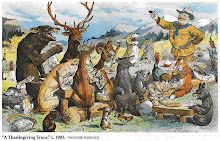Are badgers back in Orange County?
For several years, scientists believed that development and poor management of open spaces in had driven them away. Now sightings of the so-called "indicator species" are raising questions about how our habitats are doing.
Badgers might be back in Orange County, a sign that could indicate the county’s open space is more hospitable to top predators, such as badgers and mountain lions, than previously believed.
In February, a family shot video of a badger passing through their backyard near Santiago Oaks Regional Park in Orange. Scientists later verified that the animal on the video was, indeed, a badger, making it the county’s first documented badger sighting in eight years.
What’s less clear is if the badger in the video is part of a local population that is growing or dwindling.
For several years, scientists and environmentalists believed that development and poor management of open spaces in Orange County had driven badgers away.
Now, with the video, they’re not so sure.
“If they were to increase, I think that would be a positive sign to show that conserved lands were working and actually able to support such a large-ranging species,” said Cheryl Brehme, a biologist with the United States Geological Survey who studies badgers.
“It would be a positive sign for the reserve system.”
Little research exists on badger populations in Orange County, but experts generally assume populations declined during the past half century as housing tracts, freeways and parking lots replaced open space. The county’s last documented badger sighting was in 2006, with previous sightings in 2004 and 2001.
“That could be a chance sighting, or it could be that their numbers are increasing. We’re not sure,” said Megan Lulow about the February video. Lulow is the director of science initiatives at the Irvine Ranch Conservancy, which manages 50,000 acres of land in and around the Santa Ana Mountains.
“So there’s interest in learning more about their abundance in our open space lands.”
Badgers’ habits make it difficult to research them even without their population reduced. The short, stocky carnivores are hard to spot because they avoid humans and usually stick to scrubland and grassy areas where they easily slip through the stalks of grass or around brush.
In recent years, a lot of previously unmanaged land has been given over to managed conservation areas. With land management comes managers who want data on how well the land is serving animals like badgers.
And badgers are doubly important to track because they are an indicator species, meaning it’s likely that if badgers are doing well, other animals in the ecosystem also are doing well.
That’s especially true when a species is found in a so-called habitat corridor. Since badgers roam great distances and can have home ranges as big as 2,000 acres, areas they frequent are likely hotspots where other animals cross among segments of fragmented landscape, according to Lulow.
“If they’re hit on a roadway, that may be an indicator of that roadway being a corridor,” Lulow said.
With such information, land managers could build wildlife crossings over roadways where animals congregate or build fencing to keep animals off busy highways, Lulow said.
Efforts are already underway in San Diego County to collect information on badger sightings there, and researchers with the United States Geological Survey also are interested in collecting information on Orange County badgers. They’re asking citizens to report badger sightings in both counties to the USGS.
In 2011, the USGS started a program to estimate badger abundance by using dogs to sniff out badger scat. The survey concluded that badgers do indeed live in the highlands of eastern San Diego County, but suggested more research was needed to figure out their exact abundance and movement patterns.
The California Department of Fish and Wildlife listed badgers as a species of special concern, but they are not listed as endangered on state or national lists.
The information that badgers provide is similar to what mountain lions offer because both are top predators with large ranges. But the two animals traverse different sorts of habitats.
Badgers – squat, gray and the less sexy of the two – have been less studied than the lithe mountain lions. Research into both animals’ ranges would provide a more holistic picture of habitat interconnectedness, since badgers dwell in upland grasslands and scrubland while lions lurk in more heavily wooded lowland and riparian habitats.
Knowing the movement patterns of both species will help land managers assess whether habitats are connected for all sorts of species.
The research won’t be easy since badgers are also notoriously hard to spot.
“They seem to be fairly secretive in that when they occur people don’t see them very much. Typically people only know if they’re around if they see roadkill,” said Brehme, the USGS biologist.











No comments:
Post a Comment